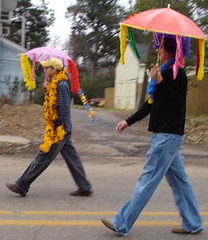Monday, February 07, 2005
Carpe diem: the last Carnival quiz before Lent
1. The term Carnival derives from the a) French b) German c) Latin d) English.
2. Carnival means a) Let us celebrate! b) A journey to the New World! c) Goodbye to flesh! d) Wine and feasting for all!
3. Rex is the best-known krewe of New Orleans but it is not quite the oldest. That distinction belongs to the Mystick Krewe of a) Zulu b) Proteus c) Comus.
4. T / F New Orleans Mardi Gras was not affected by the graceful dancing and festive costumes seen on African-American slaves as they gathered every Sunday in Congo Square.
5. Nova Scotia was known to the French as a) Canada b) New France c) Acadia
d) Haiti North.
6. Which group of French-speaking colonists came to Louisiana first? a) the Acadians, popularly known as the Cajuns b) French colonists under Governors Iberville and Bienville.
7. The principal region from which slaves were brought to the New World: a) North Africa b) East Africa c) South Africa d) West Africa.
8. The nation that is home to the Roman Catholic Church and place where the first Carnival masking and parades were seen: a) Italy b) France c) England.
9. T / F The term Creole comes from the Spanish word for cry. It referred to the cry of a baby born to parents who have emigrated to the New World.
10. Louisiana's Carnival season begins on January 6. That day is also known as a) Twelfth Night b) Tableau Night c) Dionysus Night.
11. Shreveport-Bossier has perhaps half a dozen parading krewes. The New Orleans
area has some a) 25 b) 50 c) 300 parades.
12. The immediate source for traditions and materials in Louisiana's early carnival festivities was a) Paris b) Rome c) Venice d) London.
13. In the city of New Orleans, which was developed first? a) Jazz music b) Mardi Gras.
14. What force connects the culture of South Louisiana to Carnival and makes it difficult for North Louisiana to do the same? a) racial heritage b) poverty
c) socio-religious culture d) history.
15. What unites the various US states who have the biggest propensity to Carnival? a) telecommunications b) the Gulf c) love of costumes d) music.
16. Which group of European colonists used the port of Cadiz as their point of embarkation and debarkation to Louisiana? a) Spain b) France c) Italy d) Portugal.
17. Which group of people spent a year or two on a Caribbean island before being allowed to work in the American colonies? a) Acadians b) Africans c) Creoles.
18. T / F Ethiopia, Nigeria, the Congo: these are the West African nations of America's heritage.
1. Latin / Italian 2. Goodbye to meat, or flesh. 3. Comus, which no longer offers a parade. 4. False. The Congo Square dancers were a magnet for the carriage class. Congo Square has been called New Orleans' first tourist attraction. 5. Acadia 6. The French colonists began immigrating about 1700; the Acadians arrived during the Spanish administration - the 1770's. 7. West Africa
8. Italy 9. Yes. 10. Twelfth Night 11. some 50 parades over a 3-week period 12. Paris 13. Carnival and Mardi Gras had been a part of the city from 1699; jazz was created in the 1890's. 14. socio-religious unawareness 15. The Gulf coast
16. Cadiz, Spain 17. West Africans 18. No; one of these nations is East African
- Ethiopia.
Subscribe to:
Post Comments (Atom)

No comments:
Post a Comment